Multi-mJ Scaling of 5-Optical Cycle, 3 µm OPCPA
Abstract
:1. Introduction
2. Choice of Non-Linear Crystals and Simulation Parameters
2.1. Mid-IR Materials for 3 µm Amplification Pumped at 1 µm
2.2. Amplification Parameters and Numerical Model
3. Results
3.1. Single OPCPA Stage
3.2. Multiple OPCPA Stages
4. Analysis and Discussion
5. Conclusions
Author Contributions
Funding
Institutional Review Board Statement
Informed Consent Statement
Data Availability Statement
Conflicts of Interest
References
- Tian, K.; He, L.; Yang, X.; Liang, H. Mid-infrared few-cycle pulse generation and amplification. Photonics 2021, 8, 290. [Google Scholar]
- Popmintchev, T.; Chen, M.C.; Popmintchev, D.; Arpin, P.; Brown, S.; Ališauskas, S.; Andriukaitis, G.; Balčiunas, T.; Mücke, O.D.; Pugzlys, A.; et al. Bright coherent ultrahigh harmonics in the keV X-ray regime from mid-infrared femtosecond lasers. Science 2012, 336, 1287–1291. [Google Scholar] [PubMed]
- Ghimire, S.; Reis, D.A. High-harmonic generation from solids. Nat. Phys. 2018, 15, 10–16. [Google Scholar]
- Young, L.; Ueda, K.; Gühr, M.; Bucksbaum, P.H.; Simon, M.; Mukamel, S.; Rohringer, N.; Prince, K.C.; Masciovecchio, C.; Meyer, M.; et al. Roadmap of ultrafast X-ray atomic and molecular physics. J. Phys. B At. Mol. Opt. Phys. 2018, 51, 032003. [Google Scholar]
- Hernández-García, C.; Popmintchev, T.; Murnane, M.M.; Kapteyn, H.C.; Plaja, L.; Becker, A.; Jaron-Becker, A. Isolated broadband attosecond pulse generation with near- and mid-infrared driver pulses via time-gated phase matching. Opt. Express 2017, 25, 11855–11866. [Google Scholar] [PubMed]
- Chang, Z.; Corkum, P.B.; Leone, S.R. Attosecond optics and technology: Progress to date and future prospects [Invited]. J. Opt. Soc. Am. B 2016, 33, 1081. [Google Scholar]
- Woodbury, D.; Feder, L.; Shumakova, V.; Gollner, C.; Schwartz, R.; Miao, B.; Salehi, F.; Korolov, A.; Pugžlys, A.; Baltuška, A.; et al. Laser wakefield acceleration with mid-IR laser pulses. Opt. Lett. 2018, 43, 1131–1134. [Google Scholar]
- Pires, H.; Baudisch, M.; Sanchez, D.; Hemmer, M.; Biegert, J. Ultrashort pulse generation in the mid-IR. Prog. Quantum Electron. 2015, 43, 1–30. [Google Scholar]
- Ma, C.; Wang, C.; Gao, B.; Adams, J.; Wu, G.; Zhang, H. Recent progress in ultrafast lasers based on 2D materials as a saturable absorber. Appl. Phys. Rev. 2019, 6, 041304. [Google Scholar]
- Jiang, T.; Yin, K.; Wang, C.; You, J.; Ouyang, H.; Miao, R.; Zhang, C.; Wei, K.; Li, H.; Chen, H.; et al. Ultrafast fiber lasers mode-locked by two-dimensional materials: Review and prospect. Photonics Res. 2020, 8, 78. [Google Scholar]
- Thiré, N.; Maksimenka, R.; Kiss, B.; Ferchaud, C.; Gitzinger, G.; Pinoteau, T.; Jousselin, H.; Jarosch, S.; Bizouard, P.; Di Pietro, V.; et al. Highly stable, 15 W, few-cycle, 65 mrad CEP-noise mid-IR OPCPA for statistical physics. Opt. Express 2018, 26, 26907. [Google Scholar] [PubMed]
- Elu, U.; Baudisch, M.; Pires, H.; Tani, F.; Frosz, M.H.; Köttig, F.; Ermolov, A.; Russell, P.S.J.; Biegert, J. High average power and single-cycle pulses from a mid-IR optical parametric chirped pulse amplifier. Optica 2017, 4, 1024. [Google Scholar]
- Mero, M.; Petrov, V. High-power, few-cycle, angular dispersion compensated mid-infrared pulses from a noncollinear optical parametric amplifier. IEEE Photonics J. 2017, 9, 1–8. [Google Scholar] [CrossRef]
- Archipovaite, G.M.; Petit, S.; Delagnes, J.C.; Cormier, E. 100 kHz Yb-fiber laser pumped 3 µm optical parametric amplifier for probing solid-state systems in the strong field regime. Opt. Lett. 2017, 42, 891–894. [Google Scholar]
- Fu, Y.; Xue, B.; Midorikawa, K.; Takahashi, E.J. TW-scale mid-infrared pulses near 3.3 µm directly generated by dual-chirped optical parametric amplification. Appl. Phys. Lett. 2018, 112, 241105. [Google Scholar] [CrossRef]
- Zhao, K.; Zhong, H.; Yuan, P.; Xie, G.; Wang, J.; Ma, J.; Qian, L. Generation of 120 GW mid-infrared pulses from a widely tunable noncollinear optical parametric amplifier. Opt. Lett. 2013, 38, 2159–2161. [Google Scholar]
- Zou, X.; Li, W.; Qu, S.; Liu, K.; Li, H.; Wang, Q.J.; Zhang, Y.; Liang, H. Flat-top pumped multi-millijoule mid-infrared parametric chirped-pulse amplifier at 10 kHz repetition rate. Laser Photonics Rev. 2021, 15, 2000292. [Google Scholar] [CrossRef]
- Wang, S.; Gerrity, M.; Backus, S.; Murnane, M.M.; Kapteyn, H.C.; Cousin, S.L. Multi-mJ, 1 kHz, 3.1 µm OPCPA. In Proceedings of the Conference on Lasers and Electro-Optics, San Jose, CA, USA, 14–19 May 2017; Optical Society of America: San Diego, CA, USA, 2017; p. STh1L.5. [Google Scholar]
- He, H.; Wang, Z.; Hu, C.; Jiang, J.; Qin, S.; He, P.; Zhang, N.; Yang, P.; Li, Z.; Wei, Z. 520-µJ mid-infrared femtosecond laser at 2.8 µm by 1-kHz KTA optical parametric amplifier. Appl. Phys. B 2018, 124, 31. [Google Scholar]
- Andriukaitis, G.; Balčiūnas, T.; Ališauskas, S.; Pugžlys, A.; Baltuška, A.; Popmintchev, T.; Chen, M.C.; Murnane, M.M.; Kapteyn, H.C. 90 GW peak power few-cycle mid-infrared pulses from an optical parametric amplifier. Opt. Lett. 2011, 36, 2755–2757. [Google Scholar]
- Mitrofanov, A.V.; Sidorov-Biryukov, D.A.; Voronin, A.A.; Pugžlys, A.; Andriukaitis, G.; Stepanov, E.; Ališauskas, S.; Flöri, T.; Fedotov, A.B.; Panchenko, V.Y.; et al. Subterawatt femtosecond pulses in the mid-infrared range: New spatiotemporal dynamics of high-power electromagnetic fields. Physics-Uspekhi 2015, 58, 89. [Google Scholar]
- Fattahi, H.; Barros, H.G.; Gorjan, M.; Nubbemeyer, T.; Alsaif, B.; Teisset, C.Y.; Schultze, M.; Prinz, S.; Haefner, M.; Ueffing, M.; et al. Third-generation femtosecond technology. Optica 2014, 1, 45–63. [Google Scholar]
- Alismail, A.; Wang, H.; Barbiero, G.; Altwaijry, N.; Hussain, S.A.; Pervak, V.; Schweinberger, W.; Azzeer, A.M.; Krausz, F.; Fattahi, H. Multi-octave, CEP-stable source for high-energy field synthesis. Sci. Adv. 2020, 6, eaax3408. [Google Scholar]
- Lang, T.; Harth, A.; Matyschok, J.; Binhammer, T.; Schultze, M.; Morgner, U. Impact of temporal, spatial and cascaded effects on the pulse formation in ultra-broadband parametric amplifiers. Opt. Express 2013, 21, 949. [Google Scholar]
- Petrov, V.; Noack, F.; Stolzenberger, R. Seeded femtosecond optical parametric amplification in the mid-infrared spectral region above 3 µm. Appl. Opt. 1997, 36, 1164–1172. [Google Scholar]
- Petrov, V.; Noack, F. Mid-infrared femtosecond optical parametric amplification in potassium niobate. Opt. Lett. 1996, 21, 1576–1578. [Google Scholar] [PubMed]
- Baudisch, M.; Hemmer, M.; Pires, H.; Biegert, J. Performance of MgO:PPLN, KTA, and KNbO3 for mid-wave infrared broadband parametric amplification at high average power. Opt. Lett. 2014, 39, 5802. [Google Scholar]
- Furukawa, Y.; Kitamura, K.; Alexandrovski, A.; Route, R.; Fejer, M.; Foulon, G. Green-induced infrared absorption in MgO doped LiNbO3. Appl. Phys. Lett. 2001, 78, 1970–1972. [Google Scholar]
- Bach, F.; Mero, M.; Chou, M.H.; Petrov, V. Laser induced damage studies of LiNbO3 using 1030-nm, ultrashort pulses at 10–1000 kHz. Opt. Mater. Express 2017, 7, 240–252. [Google Scholar]
- Malitson, I.H.; Dodge, M.J. Refractive-index and birefringence of synthetic sapphire. J. Opt. Soc. Am. 1972, 62, 1405. [Google Scholar]
- Zelmon, D.E.; Small, D.L.; Page, R. Refractive-index measurements of undoped yttrium aluminum garnet from 0.4 to 5.0 µm. Appl. Opt. 1998, 37, 4933–4935. [Google Scholar]
- Li, H. Refractive index of alkaline earth halides and its wavelength and temperature derivatives. J. Phys. Chem. Ref. Data 1980, 9, 161–290. [Google Scholar]
- Yin, Y.; Li, J.; Ren, X.; Wang, Y.; Chew, A.; Chang, Z. High-energy two-cycle pulses at 3.2 µm by a broadband-pumped dual-chirped optical parametric amplification. Opt. Express 2016, 24, 24989–24998. [Google Scholar] [PubMed]
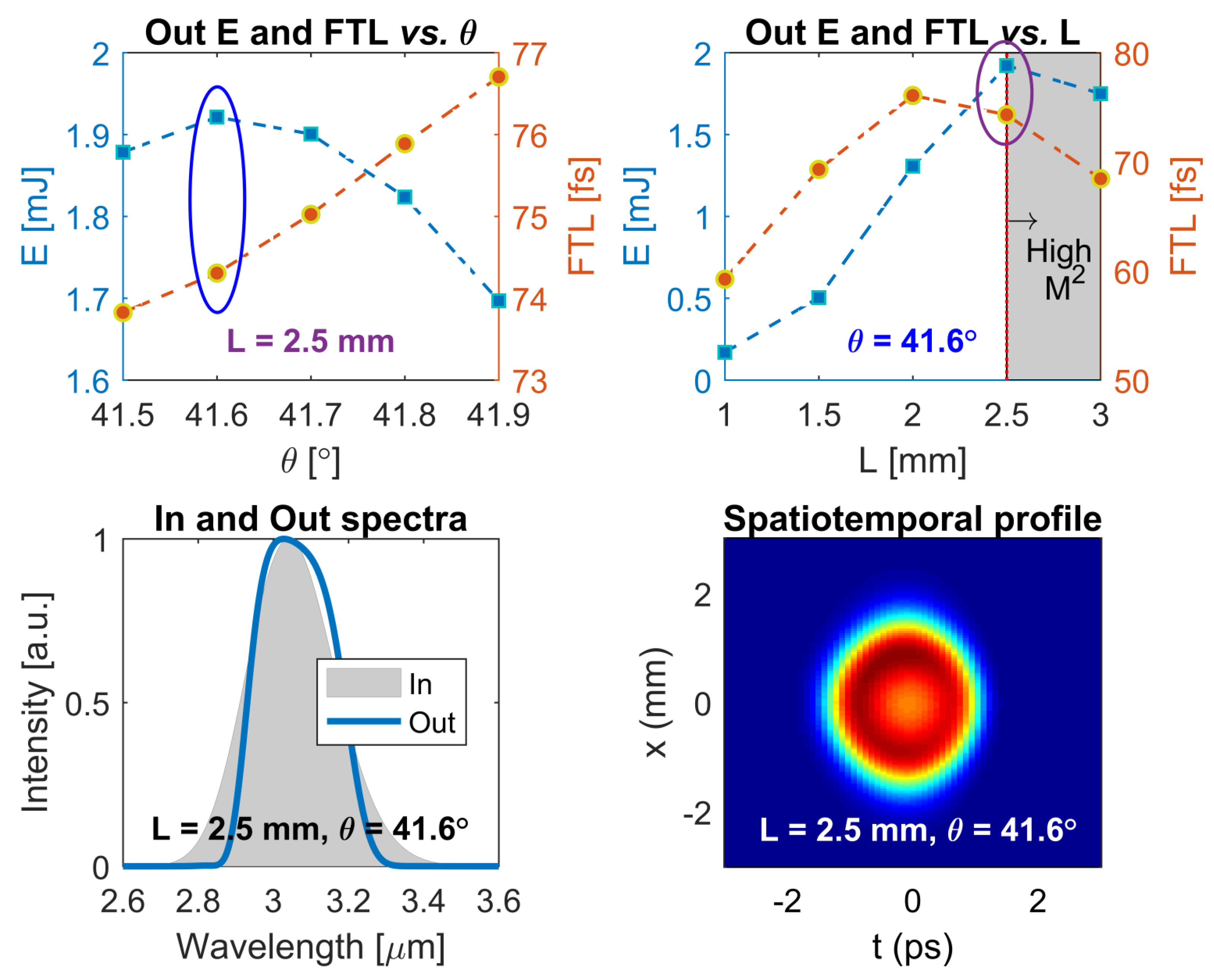
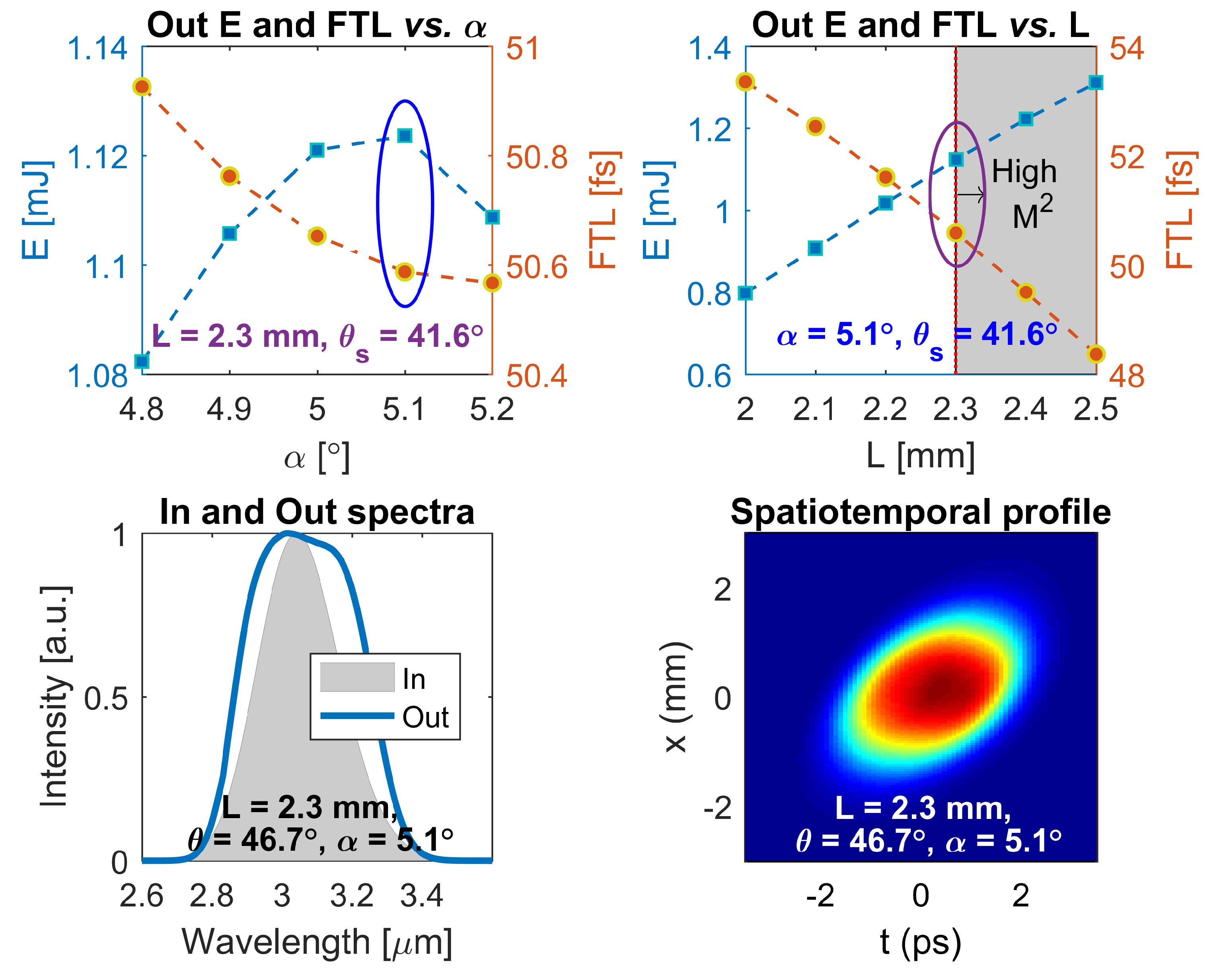

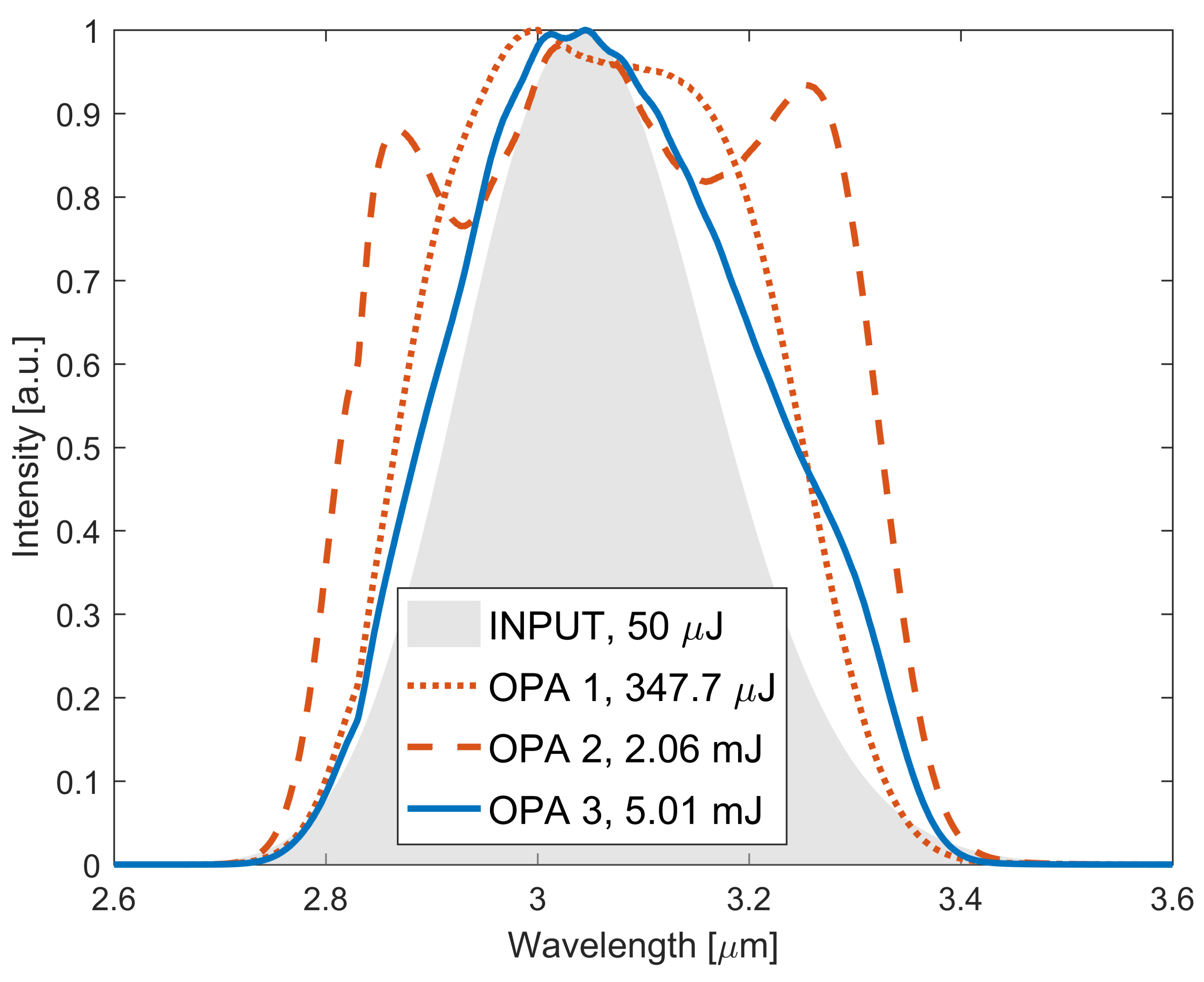
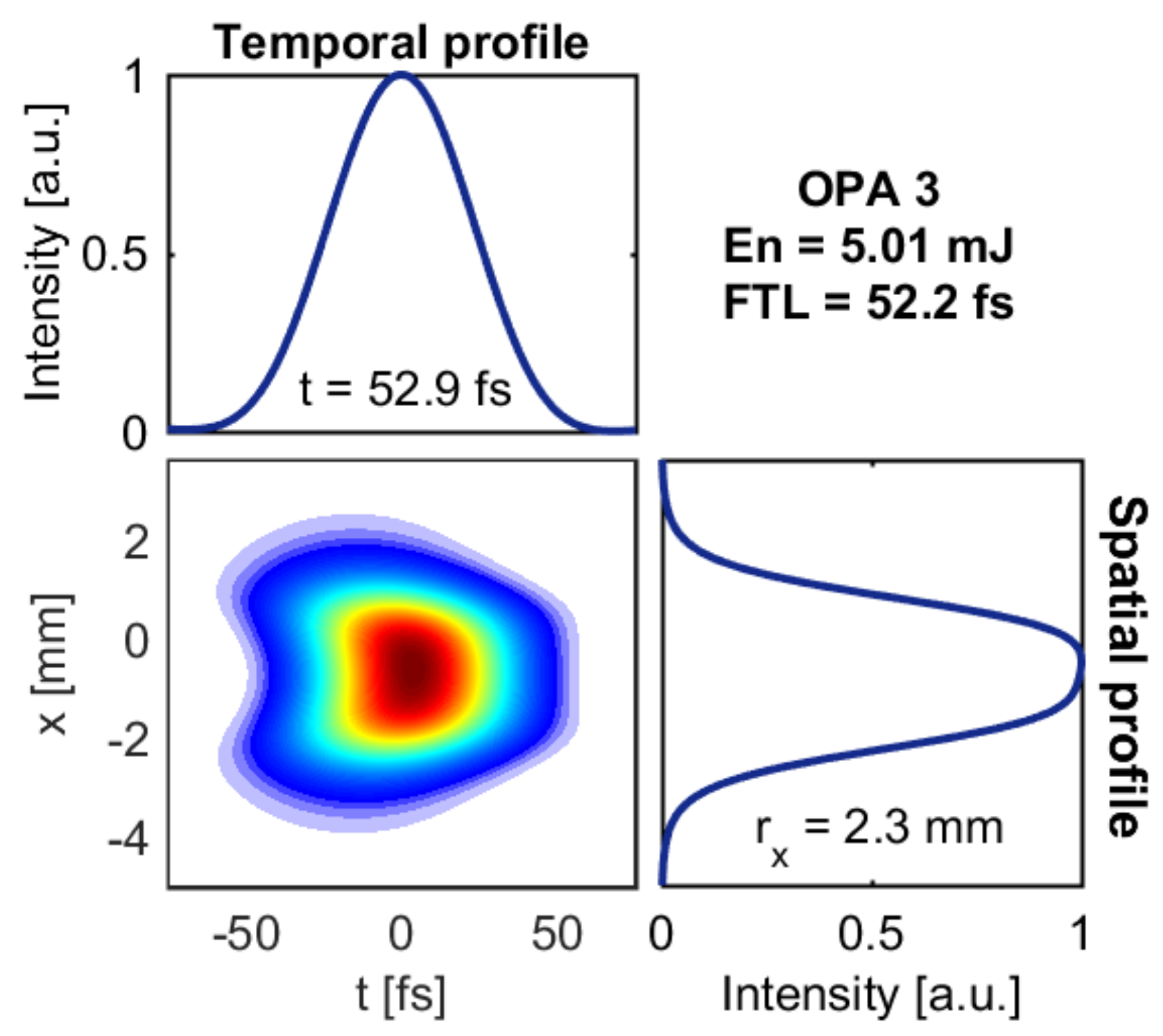
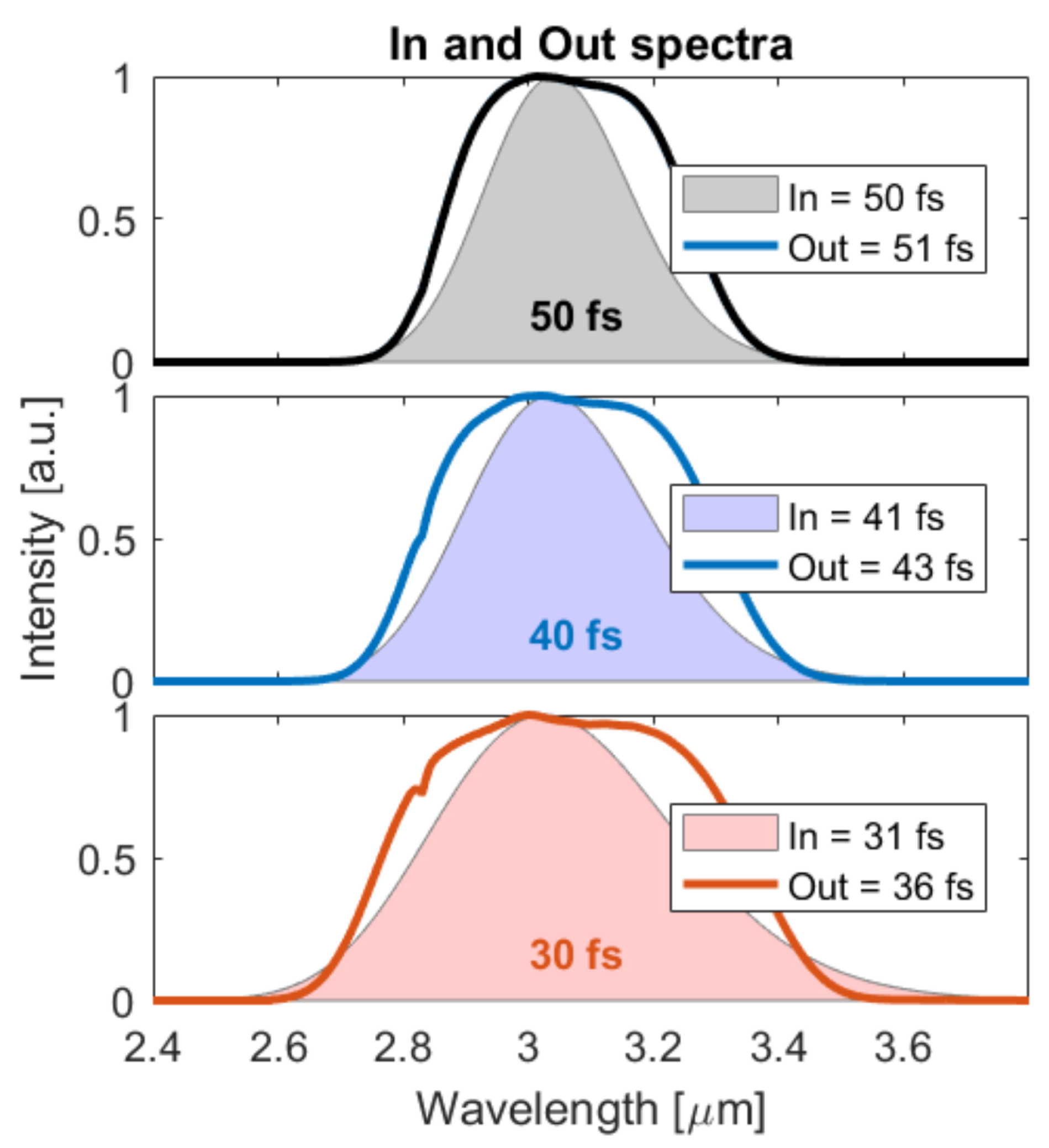
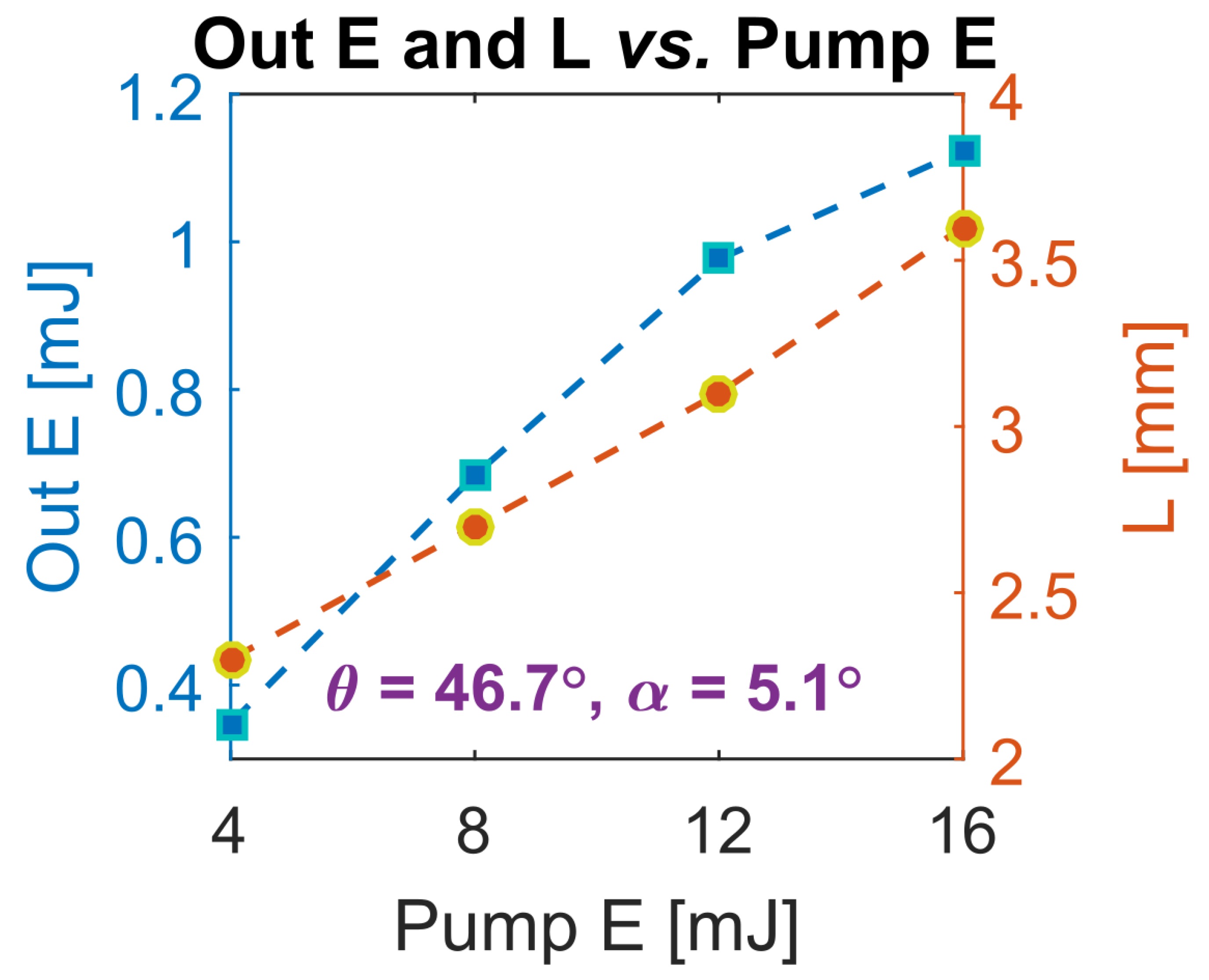
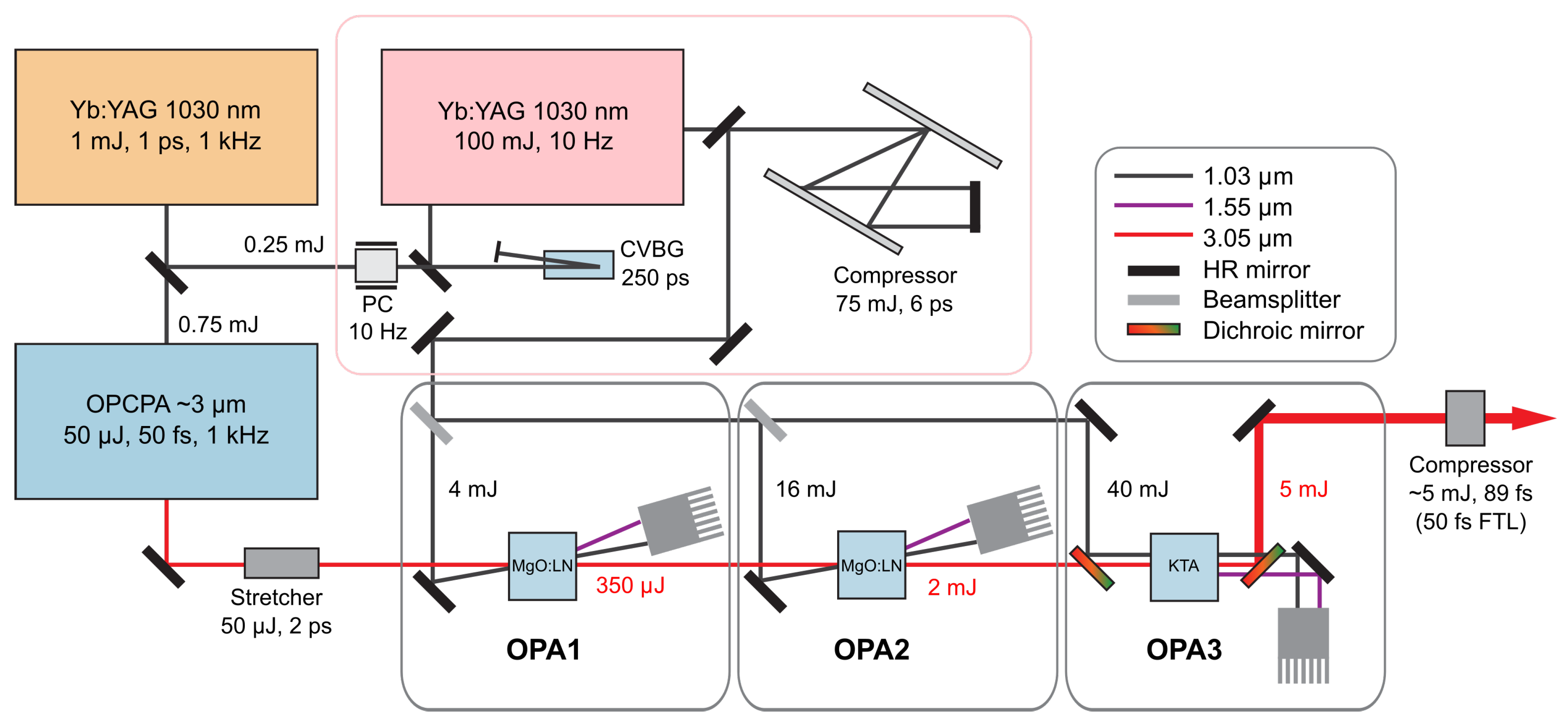
| Crystal | deff (pm/V) | LIDT (GW/cm2) | Bandwidth (nm) |
|---|---|---|---|
| MgO:LN | 3.9 | 204 ± 4 (1030 nm, 10 kHz, 1 ps) [15] | 495 (Type I, = 40.3, = 5) |
| KN | 6.0 | >14.4 (1064 nm, 160 kHz, 9.5 ps) [27] | 670 (Type I, = 40.7, = 4.5) |
| KTA | 2.1 | >200 (740–840 nm, 1 kHz, 0.2 ps) [25] | 208 (Type II, = 41.6) |
| Single OPCPA | Stage | |
|---|---|---|
| Crystal | MgO:LN | KTA |
| Pump (mJ) | 16 | 40 |
| Radius (mm) | 2.5 | 2.5 |
| Length (mm) | 2.3 | 2.5 |
| () | 46.7 | 41.6 |
| () | 5.1 | - |
| Out (nm) | 3054 | 3130 |
| Out energy (mJ) | 1.12 | 1.92 |
| Out FTL (fs) | 51 | 74 |
| Out cycles | 5 | 7 |
| Eff conversion (%) | 7.0 | 4.8 |
| Gain | 22.4 | 38.4 |
| Stage | OPA1 | OPA2 | OPA3 |
|---|---|---|---|
| Crystal | MgO:LN | KTA | |
| Crystal length (mm) | 3.6 | 2 | 1.4 |
| Phase matching angle | 46.7° | 41.6° | |
| Non-collinear angle | 5.1° | – | |
| Pump energy (mJ) | 4 | 16 | 40 |
| Output energy (mJ) | 0.35 | 2.06 | 5.01 |
| Equivalent FTL duration (fs) | 53 | 47 | 52 |
| Refs. | (mJ) | (mJ) | (fs) | RR (kHz) | Medium | Eff. (%) | |
|---|---|---|---|---|---|---|---|
| [15] | 3.3 | 630 | 21 | 70 | 0.01 | MgO:LiNbO3 | 3.3 |
| [16] | 3.4 | 900 | 13.3 | 111 | 0.01 | LiNbO3 | 1.5 |
| [17] | 3.0 | 25 | 2.7 | 50 | 10 | PPLN + KTA | 10.8 |
| [18] | 3.1 | 27 | 0.85 | 420 | 1 | MgO:PPLN | 3.2 |
| [19] | 2.8 | 12 | 0.52 | 100 | 1 | BBO + KTA | 4.4 |
Publisher’s Note: MDPI stays neutral with regard to jurisdictional claims in published maps and institutional affiliations. |
© 2021 by the authors. Licensee MDPI, Basel, Switzerland. This article is an open access article distributed under the terms and conditions of the Creative Commons Attribution (CC BY) license (https://creativecommons.org/licenses/by/4.0/).
Share and Cite
Alves, J.; Pires, H.; João, C.P.; Figueira, G. Multi-mJ Scaling of 5-Optical Cycle, 3 µm OPCPA. Photonics 2021, 8, 503. https://doi.org/10.3390/photonics8110503
Alves J, Pires H, João CP, Figueira G. Multi-mJ Scaling of 5-Optical Cycle, 3 µm OPCPA. Photonics. 2021; 8(11):503. https://doi.org/10.3390/photonics8110503
Chicago/Turabian StyleAlves, Joana, Hugo Pires, Celso P. João, and Gonçalo Figueira. 2021. "Multi-mJ Scaling of 5-Optical Cycle, 3 µm OPCPA" Photonics 8, no. 11: 503. https://doi.org/10.3390/photonics8110503
APA StyleAlves, J., Pires, H., João, C. P., & Figueira, G. (2021). Multi-mJ Scaling of 5-Optical Cycle, 3 µm OPCPA. Photonics, 8(11), 503. https://doi.org/10.3390/photonics8110503






